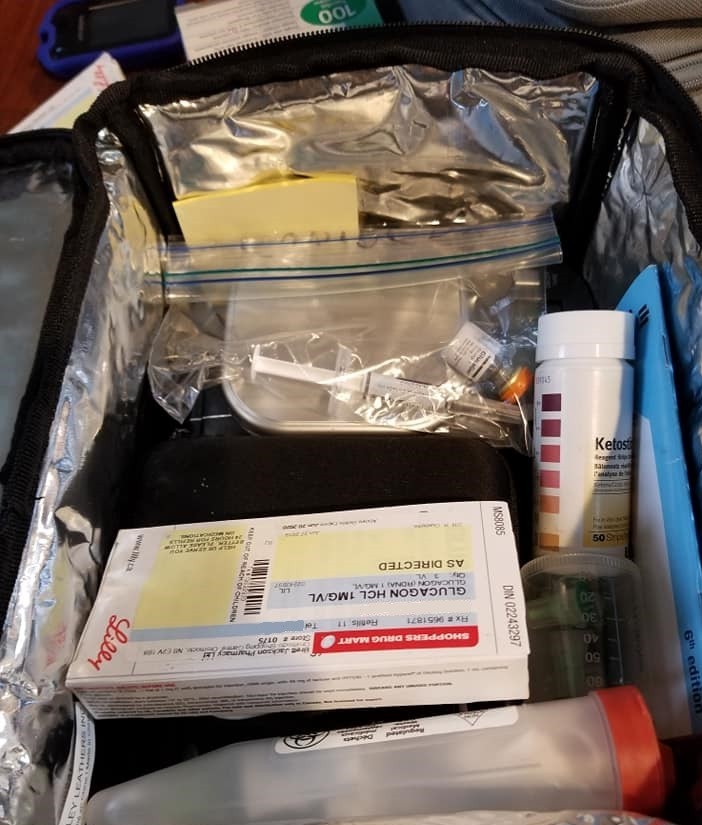With careful planning, travelling with Type 1 Diabetes is not only possible but can also be enjoyable. Good planning includes talking to your health care provider and doing a little research before leaving, careful packing, and knowing about airport security
Table of Contents
Planning is Crucial
Travelling to new places can get you out of your normal routine—that’s a big part of the fun. Delayed meals, unfamiliar food, and being more active than usual, combined with being in different time zones can all disrupt diabetes management. Plan ahead so you can count on more fun and less worry both on the way and when you get to your destination.
Before You Leave
Good planning includes talking to your health care provider and doing a little research before leaving, careful packing, and knowing about airport security if you are planning to fly.
- Talk to your doctor about your travel plans.
- If you’re on insulin, ask about getting a prescription for a glucagon kit.
- Make sure your immunizations, your immunization record and your written health record are up to date, especially if travelling abroad.
- Take a copy of the immunization record and health report if needed.
- Make sure that all medications you carry and all diabetes supplies have their prescription labels on them. If you use a daily or weekly medication reminder pack, take the original prescription labels with you.
- Refill any prescriptions that may expire during your travel. Outside of the U.S., some medications, such as insulin, are sold in different strengths.
- Keep your health insurance card on you at all times. Review health insurance policy for travel information. Is your travel destination in your provider network? If not, learn what you have to do to have insurance coverage out of network.
- For insulin pump or continuous glucose monitoring sensor users, check the insulin pump manufacturer’s website or call their customer service phone number for information about travelling.

- Just in case, locate pharmacies and clinics close to where you’re staying.
- Get a medical ID bracelet that states you have diabetes and any other health conditions.
- Get travel insurance in case you miss your flight or need medical care.
If Travelling by Plane
- Go to the Transportation Security Administration website and learn about any rules for travelling with diabetes supplies and equipment. Look for information about using a blood glucose meter, insulin pump or personal continuous glucose monitor on a plane.
- Check the Centre for Disease Control website to see if you need any immunizations for countries outside of the U.S.
- Bring enough supplies and medications to last longer than the length of your trip. You will need extras if you have travel delays or lose some supplies.
- Keep supplies, including insulin, in a carry-on bag. To prevent freezing, don’t put your insulin in checked baggage. Bring food to help prevent low blood sugar in a case you miss a meal. Bring treatment for low blood sugar.
- Give yourself extra time in airports. Some security screeners don’t know about insulin delivery mechanisms and blood glucose monitoring, so delays can happen.
- If you’re wearing an insulin pump and you have diabetes supplies with you, tell the security staff that you have diabetes. If the screeners or other security staff questions you, ask to speak with a supervisor.
- Don’t send your insulin pump or continuous glucose monitor through X-ray machines. Disconnect them if you go through an airport body scanner. You may request a pat-down screening if you don’t want to remove or can’t remove your device.
- Get up and walk the aisle every hour or so to prevent blood clots(diabetics are at much higher risk).
Travelling by Car
If travelling with a child diabetic ensure they are properly secured in a car seat according to your countries regulations.

If you’re driving, pack a cooler with healthy foods and plenty of water to drink.
Don’t store insulin or diabetes medicine in direct sunlight or a hot car; keep them in the cooler too. Don’t put insulin directly on ice or a gel pack.
Heat can also damage your blood sugar monitor, insulin pump, and other diabetes equipment. Don’t leave them in a hot car, by a pool, in direct sunlight, or on the beach. The same goes for supplies such as test strips.
Stop and get out of the car and walk around every hour or two to prevent blood clots (diabetics are at higher risk).
Set an alarm on your phone for taking your meds or checking glucose if you’re travelling across time zones
While Travelling
Monitor your blood glucose more often than you usually do. If you’re not sure how often, ask your health care provider before you travel.
Stay as close to your usual schedule as much as possible. Check the time settings on your meter and pump. Change if needed.
During travel and while at your location, don’t leave insulin and temperature-sensitive supplies in a car or any place that could have temperature changes. Check with the manufacturer of your supplies for any specific warnings about temperature.
Arrive at Destination
Your blood sugar may be out of your target range at first, but your body should adjust in a few days. Check your blood sugar often and treat highs or lows as instructed by your doctor or diabetes educator.
If you’re going to be more active than usual, check your blood sugar before and after and make adjustments to food, activity, and insulin as needed.
Food is a huge highlight (and temptation!) on a cruise. Avoid the giant buffet, and instead, order off the spa menu (healthier choices) or low-carb menu (most ships have one) or order something tasty that fits in your meal plan from the 24-hour room service.
Don’t overdo physical activity during the heat of the day. Avoid getting a sunburn and don’t go barefoot, not even on the beach.
High temperatures can change how your body uses insulin. You may need to test your blood sugar more often and adjust your insulin dose and what you eat and drink. 
You may not be able to find everything you need to manage your diabetes away from home, especially in another country. Learn some useful phrases, such as “I have diabetes” and “where is the nearest pharmacy?”
If your vacation is in the great outdoors, bring wet wipes so you can clean your hands before you check your blood sugar.
Conclusion
Diabetes can make everyday life and travel more challenging, but it doesn’t have to keep you close to home. The more you plan, the more you’ll be able to relax and enjoy all the exciting experiences of your trip. So go ahead, plan a trip and make beautiful memories with your Type 1 Diabetic grand-child.
Thanks for stopping by, please leave your comments or questions below. I will respond.

This is a great article, my cousin has diabetes so I can share this post with her whenever she may need it. It also give me great insight on the obstacles of living with diabetes.Thank you for writing this!
Thanks for the comment Joshua.
You are a great cousin to be wanting to understand the obstacles Diabetics live with on a daily basis.
It doesn’t take long for it all to become just a normal part of every day. However things can go wrong and the more people that understand what to do the better.
Travelling is its’ own unique challenge and really needs to be planned for.
Thanks again and best of luck to you and your cousin.
Hi, I find these tips to be extremely useful although I am happy to not have diabetes myself but I am sure it doesn’t hurt to be aware of just in case.
My neighbor has diabetes and I know from her how it can keep you tied to certain hours of meals and medication takings.
Despite that, she is a very active woman, often traveling and enjoying it! So yes, I agree with you that even if it might be challenging, it’s not impossible.
Best Wishes,
Natalie
Thank you for the comment Natalie. It is awesome you enjoy good health.
Sounds like your neighbour has become quite used to managing her diabetes.
Staying on track while travelling can be a challenge but with good planning and always having appropriate snacks available for when meals are delayed it can be enjoyed.
Living with Diabetes does become a new normal and you just seem to adjust and don’t focus on it any more than necessary.
Thanks again and best wishes to you as well.
Rick
I am a type 2 myself, but a lot of this is very helpful for us as well. Keeping sugar levels stable throughout the day takes a lot of thought and planning. And travel doesn’t make it easy with different foods and different customs. Some cultures use more sugar others use more fat… Keep track of your levels and note what you ate.
And try to bring some familiar things if it is allowed to cross the border.
Thanks for a great article!
Thanks for the comment and tip, Tom. I always appreciate helpful hints as our journey is still fairly new and the two types of Diabetes do have some similarities.
You are so right about other cultures having different food and even without Diabetes finding a meal that doesn’t upset your system can be quite a challenge sometimes. I usually try to opt for fresh veggies and fruit whenever possible when venturing away from North America.
Thanks again and best of luck with your own Diabetes journey.